E-Travel Log # 6: Okanguati, the Forgotten Land
Dear students:
Moro? Nawa!
(That’s Otjiherero for ‘How are you?’ and ‘I’m
fine.’) This week, Lilia and I are visiting two schools in the Kalahari Desert region of Namibia, near Botswana. We don’t have
E-mail out there, so we’ll tell you about it when we return. In the
meantime, we’ve prepared two other reports for you. This one recounts
a trip we made last year (after our trip to Etosha) to two schools in the
northwestern part of Namibia where the Herero, Himba, Zemba and Thwa people
live. In this report, we’ll also give you an oh-so-interesting pronunciation
activity; teach you how to count to ten in Otjiherero; test your wits with
another guess-who animal poem; give you the answers to the last reports animal/flower
activity; and list more questions and answers.
in the Kalahari Desert region of Namibia, near Botswana. We don’t have
E-mail out there, so we’ll tell you about it when we return. In the
meantime, we’ve prepared two other reports for you. This one recounts
a trip we made last year (after our trip to Etosha) to two schools in the
northwestern part of Namibia where the Herero, Himba, Zemba and Thwa people
live. In this report, we’ll also give you an oh-so-interesting pronunciation
activity; teach you how to count to ten in Otjiherero; test your wits with
another guess-who animal poem; give you the answers to the last reports animal/flower
activity; and list more questions and answers.
We’ve also added animal photos we took at Etosha to this report.
OH, THOSE O-TOWNS!
After visiting Etosha last weekend, Lilia and I traveled one full day by car to the northwestern corner of Namibia. As we traveled, we noticed something oh-so-interesting: almost all of the names of the towns we passed started with the letter ‘O.’ Just for fun, try your tongue on the following O-town names. (Oh, by the way, most of the languages spoken in the northern part of Namibia are in the Bantu language family -- like Swahili -- and they mostly all have Spanish-like vowel sounds, ah-ay-ee-oh-ooh. The stress is always on the second to last syllable. So, you should be able to figure out the pronunciations without getting your tongue too tied up!)
Otjiwarongo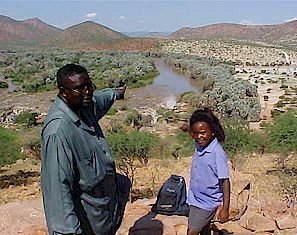
Oshiwambo
Oshakati
Ongwediva
Okatana
Okaukapukao
Oshikuku
Onamundindi
Ohangwena
Ombalantu
Okondeka
Opuo
Okanguati
Okahandja
Okaukuejo
Outjo
ULTIMATE O-WORDS
Oh, no! Is your tongue in knots? How did you do? If you got those, here's the ultimate tongue-twisting O-name on the Namibian map (and if you can pronounce this one, we'll give you the toughest one on the whole continent of Africa!).
OK, limber up your tongue! Ready? Ondundozonananandana.
Oh-me, oh-my! Could you say it? If so, give yourself a pat on the back. That's a nine-syllable O-word!
OK then, you asked for it: the continent's toughest O-name. It's the capital city of . It doesn’t have as many syllables as the last one, but it's tougher to pronounce (in our opinion). Drum roll, please ..... It's ....
Ougoudougou
Oh, boy!
WHAT’S WITH THE O’S?
As we traveled through the O-towns, we kept asking people why the names of most places begin with O. We thought maybe there was some interesting linguistic explanation; but everybody we asked just said, 'I guess the people who live here like the letter O.' Oh well.
COUNTING TO TEN IN HERERO
The majority of the
people in the region we visited this week are from the Herero ethnic group.
Their language 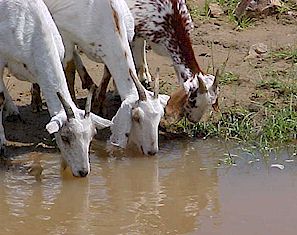 is
called Otjiherero and they call themselves Ovaherero people. They put the
prefix otji- in front of every language name and the prefix ova- in front
of every people name. So, even though nobody we spoke with seemed to know
about it, we thought maybe place names in some Namibian Bantu languages always
start with the prefix o-. What is your hypothesis? You might also notice that
all of the place names we listed also end with a vowel – another characteristic
of Bantu words.
is
called Otjiherero and they call themselves Ovaherero people. They put the
prefix otji- in front of every language name and the prefix ova- in front
of every people name. So, even though nobody we spoke with seemed to know
about it, we thought maybe place names in some Namibian Bantu languages always
start with the prefix o-. What is your hypothesis? You might also notice that
all of the place names we listed also end with a vowel – another characteristic
of Bantu words.
Here’s how to count to ten in Otjiherero. Can you see evidence (found in numbers 2-5) that Otjiherero is related to Swahili? (You may need to refer back to report #2.)
imwe
imbari
ndatu
ine
indano
hambomwe
hambombari
hambomdatu
imuviu
omorongo
NAMIBIA’S OTHER ANIMALS
As we mentioned in our last report, we saw lots and lots of animals in the Etosha National Park, but we saw even more animals as we traveled north of Etosha – only, they were almost all goats, cows and donkeys! Namibia is farmland and, since the country is too dry to grow many crops, animal farming dominates. There are some huge commercial cattle farms in Namibia and the country gains a lot of income from them. But, especially in the north, there are also many, many family farms, where people mostly raise animals for their own use or for local sale (not for export).
THE END OF THE WORLD AND THE FORGOTTEN PEOPLE
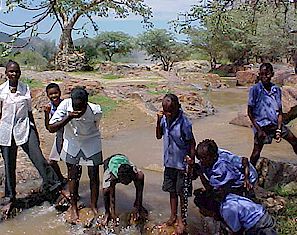 As
we traveled north, we went past The End to reach The Forgotten. Let me explain:
On our way to a small village called Okanguati near the Zebra Mountains in
the northwestern corner of Namibia, we passed through a town called Opuo,
which in Otjiherero means 'the end.' One group of people who live in Okanguati
is called the Himba, which in Otjiherero means 'the forgotten.'
As
we traveled north, we went past The End to reach The Forgotten. Let me explain:
On our way to a small village called Okanguati near the Zebra Mountains in
the northwestern corner of Namibia, we passed through a town called Opuo,
which in Otjiherero means 'the end.' One group of people who live in Okanguati
is called the Himba, which in Otjiherero means 'the forgotten.'
The Himba are interesting
because they are one of the few groups of people in Namibia who have decided,
instead of modernizing like most Namibians, to maintain, for the most part,
their traditional 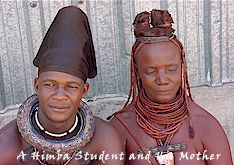 ways
of living. So, besides wearing a small goat-leather skirt, most of the women
decorate themselves with a striking array of jewelry made of leather, metal,
shells, stone, beads and ostrich shell pieces. They also paint their bodies
and plate their hair with ground ochre (the red stone/soil that is common
in the area) and goat fat. The result is a very distinctive look – and
smell (from the ochre and fat). Most of the men wear something that looks
like a pleated skirt, like what some Scottish men wear, only shorter. They
also usually shave the sides of their heads and wrap the long hair on top
in a sheath.
ways
of living. So, besides wearing a small goat-leather skirt, most of the women
decorate themselves with a striking array of jewelry made of leather, metal,
shells, stone, beads and ostrich shell pieces. They also paint their bodies
and plate their hair with ground ochre (the red stone/soil that is common
in the area) and goat fat. The result is a very distinctive look – and
smell (from the ochre and fat). Most of the men wear something that looks
like a pleated skirt, like what some Scottish men wear, only shorter. They
also usually shave the sides of their heads and wrap the long hair on top
in a sheath.
MOBILE PEOPLE, MOBILE SCHOOLS
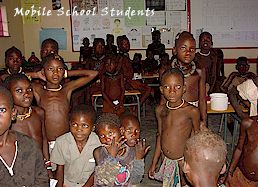 The
Himba are semi-nomadic goat herders. They generally don’t have permanent
settlements, but instead move from place to place looking for greener pastures
for their many goats. If there is sufficient food for the goats, they may
stay in an area for an extended period of time, in which case they build small
houses made of mopani tree sticks and red-soil mud. If they are just passing
through, they build even smaller shelters with just four posts and a mopani
tree stick roof (no walls). They carry all of their belongings, including
large leather capes, covered with the same traditional paint the women use
on their bodies, to protect them from the rain.
The
Himba are semi-nomadic goat herders. They generally don’t have permanent
settlements, but instead move from place to place looking for greener pastures
for their many goats. If there is sufficient food for the goats, they may
stay in an area for an extended period of time, in which case they build small
houses made of mopani tree sticks and red-soil mud. If they are just passing
through, they build even smaller shelters with just four posts and a mopani
tree stick roof (no walls). They carry all of their belongings, including
large leather capes, covered with the same traditional paint the women use
on their bodies, to protect them from the rain.
The Namibian government, which has dedicated lots of their resources to education, has done an interesting thing in their attempts to educate the Himba people. Since the Himba are always on the move, the government has created 'mobile schools' to accommodate them, complete with tents, portable teaching equipment and teachers who are willing to move their classrooms on a regular basis.
Lilia and I visited one of the mobile schools. They only go up to fourth grade (after that students must go to a permanent school if they want to continue their education), but some of the students were as old as seventeen. They never had school before, so they just started first grade when they were teenagers.
We also visited a
permanent school in Okwanguati that consists of Himba and Zemba students.
The boys there have to shave their traditional hair-dos and the girls are
not allowed to wear traditional jewelry or paint their bodies with ochre soil.
Both boys and girls have to wear school uniforms. At that school, we went
on two very interesting field trips with some students: the first to the beautiful
Epupa Falls, a huge series of waterfalls on the Kunene River, the border between
Namibia and Angola; and the second to a nearby hot spring. We also got to
see students at Okwanguati perform traditional dances, including a dance that
men used to do to build courage before going to war. When the Himba people
were fighting their colonial invaders or occupiers, men would conduct the
dance along with rhythmical chanting. It was very interesting.
=======================
Activity Answers
In the last report, we gave you a list of interesting and descriptive bird, reptile and flower names and asked if you could guess which names belonged in which category. So, here are the answers. B stands for bird, R for reptile and F for flower. If the reptile is a snake, an S follows the R.
 1.
spiny agama -- RS
1.
spiny agama -- RS
Livingston's blue commelina
-- F
pied avocet -- B
2. three-banded courser
-- B
two-striped shovel-snout -- RS
natal red top -- F
3. scimitar billed
woodhoopoe -- B
doll's powder puff -- F
snouted night adder -- RS
4. short-legged sep
-- R
pig's ear -- F
redknobbed coot -- B
5. violeteared waxbill
-- B
rhombic skaapsteker -- RS
pink-spike erica -- F
6. giant legless skink
-- R
purple berkheya -- F
purple gallinule -- B
7. fierynecked nightjar
-- B
Bibron's burrowing asp -- RS
yellow mouse-whiskers -- F
8. silver veronica
-- F
southern brown eggeater -- RS
orangethroated longclaw -- B
9. firecrowned bishop
-- B
striped blind legless skink -- R
small white albuca -- F
10. devil's thorn
-- F
forktailed drongo -- B
western dwarf burrowing skink -- R
11. variegated slugeater
-- RS
fishbone cassia -- F
rattling cisticola -- B
12. chestnutvented
titbabbler -- B
giant pink everlasting -- F
speckled padloper -- RS
13. blackcrowned tchagra
-- B
many-horned adder -- RS
wart-stemmed pincushion -- F
14. yellow bushman's
candle -- F
yellowbreasted hyliota -- B
green mamba -- RS
15. hairy nidorella
-- F
ruddy turnstone -- B
shieldnose elapid -- RS
 16.
black mamba -- RS
16.
black mamba -- RS
red paintbrush -- F
spotted dikkop -- B
17. arrowmarked babbler
-- B
red hot poker -- F
Namibian wolf -- RS
18. waterfinder --
F
monkey's tail -- F
desert broom -- F
=================================================================
GUESS WHO
Here's a guess who animal poem. It's a love song. Can you guess the crooner? You'll find the answer in the next report. Or you can visit the 'Safari!' section of the project Web site to see photos and read facts about the mystery African animal.
Tai
May I sing you a love song
My devotion is complete
From my wrinkly bald head
To my talon-sharp feet
Oh my darling, darling sweet!
I will search for you
Search far and wide for you
For you and only you
My darling, darling sweet!
I will soar for you
Soar far and high for you
Circling the sky for you
For you and only you
My darling, darling sweet!
And once you've caught my eye
I will descend for you
Descend from the highest vantage
For nothing can distract me
From you and only you
My darling, darling sweet!
And when I have descended
I will contend for you
Even with ferocious beasts
Whether lions or hyenas
I will contend for you
Nothing shall impede my appetite for you
For you and only you
My darling, darling sweet!
Then, to express my overwhelming joy at having found you
My delight and my prize
I will dance for you
I will skip and lunge and flap for you
The ballet macabre I will dance with my kin over you
Over you and only you
My darling, darling sweet!
And, at last, when we meet
I will sing to you
My devotion is complete
For once you've bitten the savanna dust
You're nothing to me but meat
My darling, darling meat!
So sweet
Let's eat!!
(My devotion is complete.)
------------------------------------------------------
By the way, the answer to the last report's poem is the rhinoceros.
QUESTIONS AND ANSWERS
Here are the answers to questions we posed to students in grades two through nine at Okanguati Combined School in Northern Namibia last year.
Do you learn different languages at school? Which ones? We learn English and Otjiherero at our school.
What natural or economic resources does your country have? Namibia has silver, copper, uranium, salt, fish from the ocean, maize, seal oil, cows, goats, sheep, millet, mopani trees (for making houses), makalani trees (for sugar), mineral water, oil (from the sea) and diamonds. We also have a lot of tourism. People come to see the animals, the deserts and to visit people who are living the traditional culture, like the Himba people who live in our region.
What sports do you play at your school? We play soccer (we call it football), volleyball, netball and track and field.
Do
you have a computer in your school? No, we don't.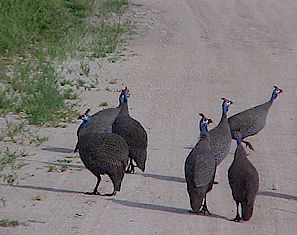
How do you celebrate your birthdays there? Some of us celebrate and some don't. We have cake, meat, juice and sweets on our birthday and we invite our friends to celebrate with us.
What is the 'countryside' like in Namibia? In our area, we have lots of trees, hills, mountains, rivers (that are dry most of the time), flowers and homes.
What is a popular boy's nane and girl's name? Popular boys names are Paulus, Josef and Hangula; and popular girls names are Bertha, Anna, Maria, Ndapewa and Himeezembi.
What religions do you practice in your country? We have Evangelical, Nazareth, Mission, Lutheran, Ba'hai, Dutch Reform and Pentacostal churches. Some people also practice a traditional religion called Holy Fire, which is based on respect for the ancestors.
What is your favorite food? We like porridge, red meat and fish.
What is the national bird of your country? The African fish eagle and the white dove are important Namibian symbols.
How
do you balance baskets on your head? From a young age, we begin to carry
things on our heads; 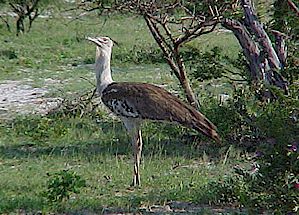 so,
by the time we are older, it is easy to do.
so,
by the time we are older, it is easy to do.
What kinds of things do you study in school? We study mathematics, life science, physical science, business, Otjiherero language, agriculture, geography, English, history, biology and physical education.
Do you have rollerblades, skateboards, scooters and bikes? Here, we have bicycles.
How do you travel around your village? We mostly travel by foot. Some people use horses and donkeys for local travel. Sometimes, people also use donkey carts, which have a two-wheeled cart hooked up to two to six donkeys.
Do you have computers and TVs in your home? Many of us have TVs and a few have computers.
How many children are in your class? In our class, there are 48 learners.
What are your favorite books? We like story books and nonfiction books that tell about history. For example, a very good book is Nelson Mandela's autobiography, A Long Walk to Freedom. Our president, Sam Nujoma has also written a book about Namibia's struggle for independence.
Have you read Harry Potter? No, we haven't heard of it.
If we could send you one thing from the USA, what would it be? We would be very happy if you sent us some library books.
THAT’S ALL FOR NOW
Well, that's it for this report. Our next report will focus on a language that is commonly spoken in Namibia – and is related to English -- Afrikaans. Till then, learn lots.
Paul and Lilia
Africa School Project Coordinators
<><><><><><><><><><><><><><><><><><><><><><><>><>>><><><><><><><><><><><><><>

